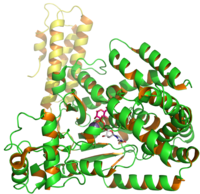
Photo from wikipedia
We thank Wong and colleagues (1) for taking our work (2) a step further by investigating the impact of a subinhibitory concentration of clindamycin on ST30 strains of community-acquired Staphylococcus… Click to show full abstract
We thank Wong and colleagues (1) for taking our work (2) a step further by investigating the impact of a subinhibitory concentration of clindamycin on ST30 strains of community-acquired Staphylococcus aureus (CA-MRSA). In our study, we observed that subinhibitory concentrations of the protein synthesis inhibitor clindamycin triggered a stress response in S. aureus via alternative sigma factor B ( B). This correlated with elevated biofilm production and was specific for the S. aureus USA300 clonal lineage. Wong and colleagues now show that a subinhibitory concentration of clindamycin under nonbiofilm conditions triggered a similar transcriptional response in CA-MRSA ST30 strains, resulting in the upregulation of B as well as agr and the PSM genes. In a next step, it will be interesting to see whether S. aureus ST30 strains also display clindamycin-dependent biofilm induction, as we observed for USA300 LAC and two USA300 clinical isolates derived from skin and soft tissues infections. The VraSR two-component sysem (TCS) is activated by cell wall-active antibiotics as well as cell wall hydrolysis or cell wall synthesis inhibition and regulates the cell wall stress response (3–6). Wong and colleagues showed that inactivation of the VraSR TCS modulated the transcription of several genes of S. aureus subjected to a subinhibitory concentration of clindamycin. We showed that clindamycin induced the upregulation of the murein hydrolase AtlA and triggered changes in cell morphology (2), which may lead to cell wall stress in S. aureus. Thus, subinhibitory concentrations of clindamycin might trigger a cell wall stress response via the VraSR TCS. The increased expression of atlA that we observed in the biofilm after clindamycin addition may be balanced by the induction of the VraSR-dependent cell wall stress response, resulting in downregulation of atlA and upregulation of cell wall biosynthesis enzymes, counteracting cell lysis. Increased biofilm formation has previously been connected to cell wall stress induced by cell wall-active antibiotics in various studies (7–9). Further investigations will be necessary to clarify the role of the VraSR TCS in the S. aureus response to subinhibitory concentrations of clindamycin and its role in biofilm induction.
Journal Title: Antimicrobial Agents and Chemotherapy
Year Published: 2017
Link to full text (if available)
Share on Social Media: Sign Up to like & get
recommendations!